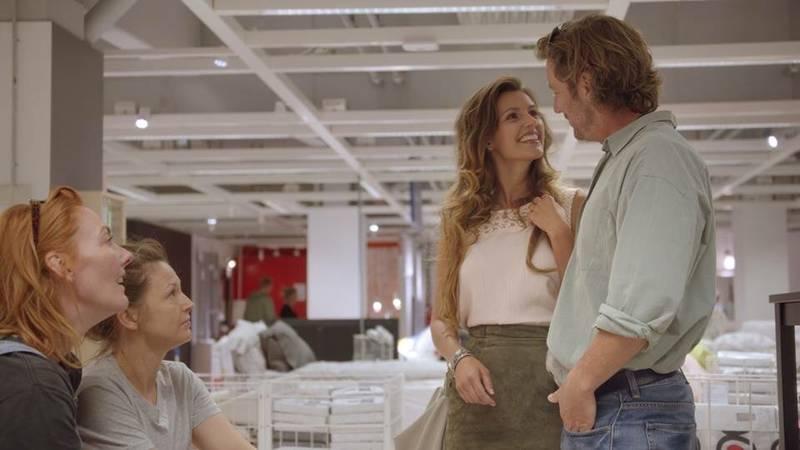
“Is it possible to thank the times we live in? Well, in any case, we would like to thank a time in which two middle-aged women having a conversation on prime-time television is considered to be brave and refreshing” (Didriksen 2016). With these words, Louise Mieritz, co-creator Ditte Hansen beside her, concluded her acceptance speech at the Robert Awards, the Danish equivalent to the Academy Awards. They had just received the award for Best Short Television Series of the Year for their comedy series Ditte & Louise, produced by DR, the Danish Broadcasting Corporation.
While strong, emasculated or empowered female protagonists dominate Danish drama series – such as Arvingerne ( The Legacy, 2014-), which took several Robert Awards on the same occasion – contemporary comedy, in contrast, seems to engage an anti-heroine to argue its feminist case. Walking in the footsteps of the American series Girls (2012-) and Inside Amy Schumer (2013-), Ditte & Louise has contributed to feminist uproar, delivered in a Danish context, by way of comedy verité, a recent genre hybrid between the traditional sitcom and new forms of the genre. Written and performed by Ditte Hansen and Louise Mieritz, Ditte & Louise (2015-) borrows its title from its stars for a reason. The series centres around two women who share professions as well as personal features with its creators and leads, thereby playing with their own personas as publicly known comedians and actors. The series also features cameos from other celebrities playing fictionalized versions of themselves.
To what extent, however, does the series update the traditional sitcom in relation to the notion of comedy verité? How does reality inform Ditte & Louise? And, what is the relationship between the female comedian and the performance of the self in the series? This article is a case study of the series aiming to answer these questions and discuss to what end this particular work of fiction merges real-life elements with fictional storytelling. The purpose of the case study is to examine the way in which Louise Mieritz and Ditte Hansen’s Ditte & Louise bring the performance of the self into play and to what effect. This will be done partly through interviews with the series’ creators and partly through a discussion of Ditte & Louise in relation to contemporary definitions and theories of situational comedy and comedy verité.
The serious business of being funny – creating Ditte & Louise
Following a hosting job at the 2012 Bodil Awards, handed out by the Danish Film Critics’ Association, Ditte Hansen and Louise Mieritz became aware that the head producers of DR had been present in the audience. They decided to act on impulse and wrote to the head of drama, Piv Bernth, at DR. They offered a pitch for a new comedy series, in line with practice at the Broadcasting Corporation which never produces pilots just for trial (Redvall 2013: 136). Encouraged by Bernth, they later sent a pitch describing the setup for an original series entitled Ditte & Louise:
“Two female comedians unflinchingly set out to conquer the male dominated entertainment business, of course with the risk of losing their sex appeal. They are constantly met with resistance, particularly from themselves: they are not as funny as the boys, nor hard-boiled enough to fight on their terms. Besides they are already way too old for this. Nevertheless, they decide to go for the power, the fame and the money. But everything comes at a price, and the question is: what are they willing to sacrifice – their sex appeal, their families or their souls?”.
(Hansen and Mieritz 2012. Translated by the author of this article).
Accordingly, Ditte Hansen and Louise Mieritz describe their series’ premise with the question: “Can women be funny? That is, really funny?” (Ibid.). Establishing this premise, they reflect the influential Hollywood writing teacher Steve Kaplan’s recipe for comedy with a universal appeal. In his book The Hidden Tools of Comedy –
The Serious Business of Being Funny, Kaplan (2013: 27) identifies “the comic equation” as a story “about an ordinary guy or gal struggling against insurmountable odds without many of the required skills and tools with which to win yet never giving up hope”. What he calls ‘comedy’ is to be understood in opposition to mere ‘humour’, which relies on personal tastes. Kaplan also stresses that a ‘lack of skills’ is the distinguishing factor between comedy and drama: in both genres, the hero or heroine will face equally insurmountable odds, but only in drama does he or she possess skills to defy them. Based upon this premise, Ditte & Louise’s anti-heroines constantly meet professional as well as personal defeats as they are turned down in the business for being too old and not funny or attractive enough.
All in all, the structure of the series emulates classical situation comedy, or sitcom, according to the definition of comedy researcher Lawrence E. Mintz:
“[A] half hour series focused on episodes involving recurrent characters within the same premise. That is, each week we encounter the same people in essentially the same setting. The episodes are finite; what happens in a given episode is generally closed off, explained, reconciled, solved at the end of the half hour… (…) The most important feature of the sitcom is the cyclical nature of the normalcy of the premise undergoing stress or threat of change and becoming restored”.
(Mintz 1985: 114-115).
Hansen and Mieritz are inspired by traditional sitcom form, which they studied in screenwriting manuals (Hansen and Mieritz 2015). This influence is evident in some respects; yet, they have made it their own in others.

The series’ two main characters are, true to conventional comedy, one another’s opposite. They are a genuine odd couple, both in physical aspects – Louise is short, dark and classy, while Ditte is tall, blonde and colourful – and in personality - Louise is controlling and introverted, but incorruptible and quality-orientated, while Ditte is chaotic and self-defeating, but open-minded and generous. Louise’s boyfriend, who is a war photographer and the father of her baby daughter, has left her for a 27-year-old and moved in with her – to Louise’s surprise in the first episode: “Do her parents really let her do that?” Meanwhile, Ditte’s husband of many years, a sweet ceramicist, is unwilling to make love to her. This is why, impulsively, she cheats on him.
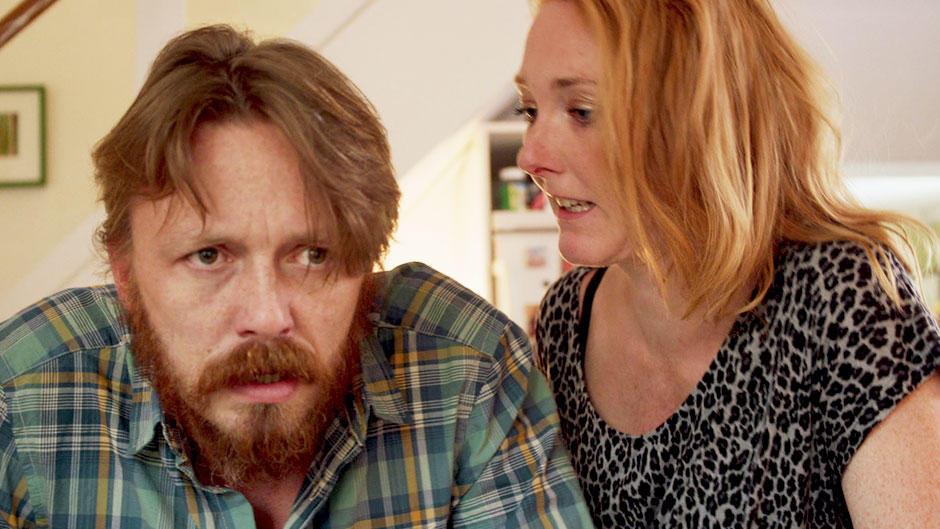
The two 43-year-olds meet after a failed casting for a part in a new Susanne Bier movie opposite real-life Danish movie star Anders W. Berthelsen, during which Ditte overhears him write them off as ‘not fuckable’, hence the title of the series’ first instalment, “Fuckable”. As a result, they share frustrations about the business. The characters then move on to express regret about the fact that women could not have made a comedy series like Casper Christensen and Frank Hvam’s Klovn (Clown, 2005-2009), of which they are both fans. Ditte and Louise decide to go into business together, but repeatedly seem to fall short of their ambitions for a variety of reasons and fail to rise professionally.
On a few, but significant, notes, however, Ditte & Louise differs from traditional sitcom form. The two protagonists do have character arcs, as opposed to traditional sitcom heroines; and, Ditte & Louise, to a certain extent, features a forward-moving character-driven plot. For one, Ditte’s infidelity has consequences, which lead to her marriage getting a second chance. And, Louise is taught a lesson about selfish war photographers, who momentarily miss their ex-girlfriends, only to abandon their family again when everyday life sets in.
When it comes to the protagonists’ professional goals, the series relies on the sitcom’s stasis. But, the overall arc centres on their friendship, which develops and grows during the course of the series’ eight 28 minutes episodes – despite the often insurmountable odds presented by their differences. Meanwhile, they expose more weaknesses than strengths, yet they possess enough of the latter to be able to laugh at themselves. In other words: “The arc is about learning how to embrace your inner witch” (Hansen and Mieritz 2015).
It was important for us to make Ditte and Louise vulnerable. The audience needs to believe they are in the company of real human beings. This is also why canned laughter was out of the question. We need to feel for Ditte and Louise as they expose their greatest weaknesses, not distance ourselves from them”.
(Hansen and Mieritz 2015).
Certainly, the series’ partly drama-inspired narrative represents an intention to make the audience connect to the protagonists. This aim, of course, is in addition to the series’ overall genre purpose: to make the audience laugh (Ibid).
Intuitive storytelling – the choice of camera style for the series
Ditte & Louise also departs from the conventional sitcom on the question of style. A significant decision was to include an element of realist drama to the series, and to pursue this not only through storytelling but through the deliberate use of visual choices. Conventional situation comedy’s camera style engages a three simultaneous angles position approach that has one camera on each of the dialoguing actors, while a third camera shoots them together, making the audience “aware of watching a play, a performance, a comedy incorporating comic activity” (Mintz 1985: 114-115). Going against a ‘more constructed’ sensation, Ditte and Louise’s principal photographer Manuel Alberto Claro devised a camera style to match the storytelling.
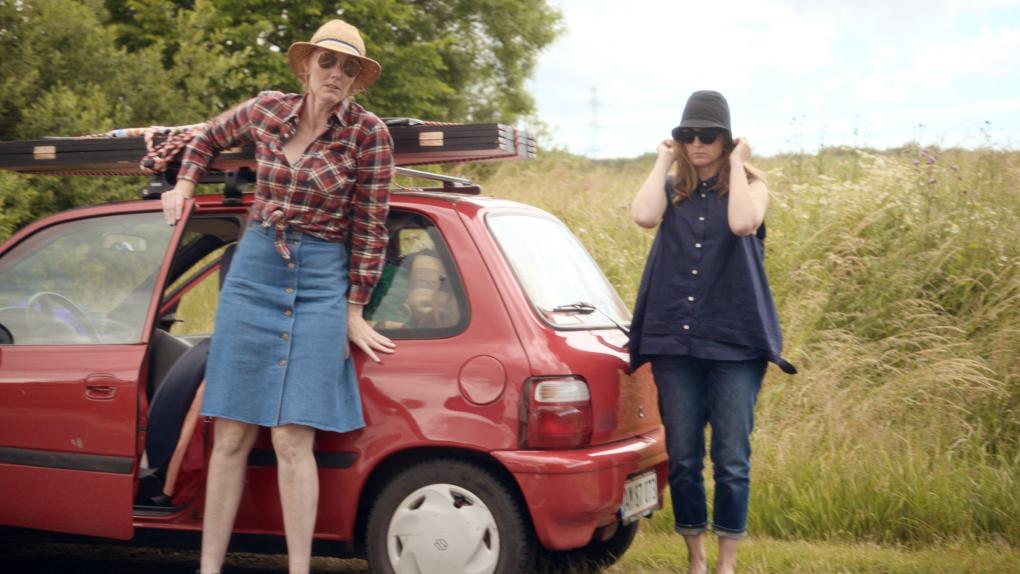
Dispensing with comedy’s often distancing style, Claro applied a method to draw in the spectator. Instead of respectively filming one actor, then the other, before concluding with a half-total shot, he used a more organically moving camera and followed the action. This creates the impression that the audience becomes a third character present in the room. Manuel Claro (2015: 7) thereby intends to steer clear of “vanity and pretentiousness” as he explains:
The ambition is to maintain the intuitive energy with which the series is written and hold on to the nakedness and vulnerability, which lie therein. My wish is to hit a clean and honest note in order to make our meeting with Ditte & Louise as engaging as possible. (…) We must love the main characters without conditions, because they represent all the challenges we as humans are met by on a daily basis. They represent a mirror without filter… also when it hurts. In order to hit this honest note, photography should be attentive in the moment and completely absorbed by Ditte and Louise each, but also by tapping into the special emotional space, which manifests itself between them. We can achieve this with a simple and flexible camera style. The life of the camera must succumb to the content and it must always search for honesty in the scene. This way we get a dynamic feel full of surprises, where the camera does not know where to place itself, but is driven by curiosity. (…) I also believe that we with this camera style can create a special feeling of improvisation, which will promote a sense of honesty, vulnerability and humour in the moment”.
(Claro 2015: 7).
The choice of photographer for Ditte & Louise in itself seems to reflect an intention to play with other genres in addition to comedy. Claro has filmed art house director Lars von Triers’ two latest films, and has brought inspiration from art photography to the comedy series. His mood book features a range of pictures with saturated colours, heavy lighting and characters seen only in parts or from the back. A main inspiration behind Ditte & Louise’s camera style is found in art photographer Ryan McGinley, who shoots naked female bodies with an emphasis on finding a light-hearted beauty in an aesthetic realism. The intention is to visually add “an intuitive storytelling” and “a more traditional feature film language” to the series by way of an “organic arrangement” (Claro 2015: 2). This hybrid between conventional situation comedy and the often more artistically inclined drama serves Ditte Hansen and Louise Mieritz’s ambition to “go beyond the laugh into something else” (Hansen and Mieritz 2012).
Also influencing the visual style choices in the series is a production design that departs from traditional sitcoms’ visual look, which often seeks a comic reaction by exaggerating, for instance, a character’s interior decoration style.
Ditte & Louise’s production designer Charlotte Bech, like the series’ photographer, is inspired by art house photography and mainly works with art house dramas. However, art house dramas typically aim to distance the viewer from the protagonist, which is not the case in Ditte & Louise:
Through the inspiration from art house films I aim to emphasise the depth in the characters and the script. I do not decorate a film, like some production designers do, I emphasise the story. Yet, in Ditte & Louise we do not go as visually far as art house dramas and we do not stylise the realism of the series. I would say that while art film and photography add an extra layer of visual design in order to create its own visual universe, we use the visual style to manipulate realism. And, our purpose in doing so is to create two characters, who are just like the rest of us, who we can connect with”.
(Bech 2016).
To exemplify her approach, Bech refers to the design of Ditte’s house in series, which is shot on location, but deliberately made too small for the tall actor. Her home is a naturalistic setting in every way possible, but shrunk in size to make the audience unwittingly feel Ditte’s claustrophobia and the emotional pressure she is under.
Ditte & Louise’s fusion between art house aesthetic style choices, dramatic character arcs and situational comedy seem to have been realized to a relatively successful degree, when one reads the positive reviews as well as the ratings, which surpassed half a million viewers. Yet, it is interesting to examine closer whether or not there is ambivalence in this frequently stated ambition by the series’ creators to be authentic, to convey truth and realism.
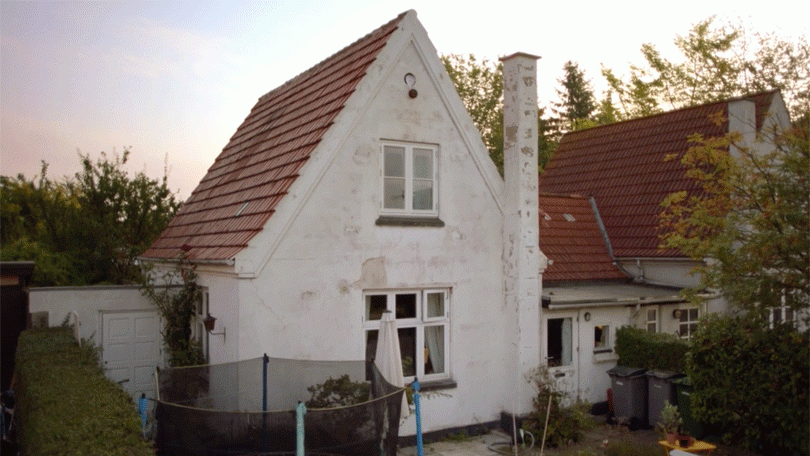
In accordance with the art house influence, within each episode of Ditte & Louise there is a stylistic ‘lift’ – a scene in every episode which distinguishes itself from the style of the series. An example of this is found in episode two, where, in a montage inspired by music videos, the protagonists flee after having falsely impersonated two famous female comedians in front of a Danish province audience. Another example is the flashback in episode five, where two girls (understood to be Ditte and Louise as children) have a brief chance meeting at the bus stop and discuss whether or not it is slutty to show one’s vagina to the boys in school. In doing so, the director aims to “transfer the head writers, Ditte and Louise’s signature edginess to the series Ditte & Louise” (Claro 2014: 2). Nevertheless, the ‘lifts’ of Ditte & Louise serve to point to the fact that what we are witnessing is not the truth, even though the series – through its use of comedy verité, as I will argue – goes to great lengths to create an illusion of conveying reality.
Inspired by true events – standing on the shoulders of Danish comedy
Arguably, Ditte & Louise’s successful merging of features from drama with those of the sitcom has allowed DR to produce a comedy series that fulfils the Broadcasting Corporation’s public service practice of double storytelling. The ‘double story’ is an exclusive production of fiction, which has the ability to educate the audience as well as entertain. As for comedy, however, Ditte & Louise is the first sitcom inspired by the original American form which has received a green light for production in several years within the realm of DR. This is despite the fact that DR has been inspired by American television production culture since then head of drama Rumle Hammerich in 1994 proclaimed a new common aim for the production department: “ ‘quality within a genre’” (cited in Redvall 2013: 60). Eva Novrup Redvall writes:
Even though DR has a long tradition of working with comedy, for instance, with the work of Erik Balling, scripted comedy has almost disappeared at DR since the shaky attempts to do Danish sitcoms in the 1990s. However, the 2000s have seen the rise of some innovative satirical formats on the sister channel DR2, targeted at content with more niche appeal”.
(Redvall 2013: 46).
According to Redvall (2013: 44), Lykke (Happy Life, 2011–2012), referred to as ‘depression comedy’, is another example of a long-running series, which, at DR, has paved the way for new comedies by challenging realism as the mode of representation. Meanwhile, the competition at TV2 has created a string of successes within or in relation to the comedy format, among them the Danish equivalent to Bridget Jones’ Dairy, Nynne (2016), Langt fra Las Vegas (Far From Las Vegas, 2001-2003) and Rita(2012-).
Tracing the female comedic couple through the history of Danish Film and Television a few significant names do manifest themselves, however. Female comedians Helle Ryslinge and Anne-Marie Helger were invited to bring their comedic theatre road show into director Christian Braad Thomsen’s 1983 film comedy Koks i kulissen (Ladies on the Rocks, 1983). Ryslinge and Helger’s claim to fame in 1980’s comedy was their satire of gender relations, inspired by the variety show and burlesque tradition. Through the 1990s another influential Danish female comedy duo manifested itself with Kirsten Lehfeldt and Søs Egelind’s TV comedy series Kongeriget (’The Kingdom’, 1998-2002). The sketch-based Kongeriget did not work with serial narrative, but Lehfeldt and Egelind presented a parade of characters, both male and female, who would return in various episodes, in their satire of the Danish people.
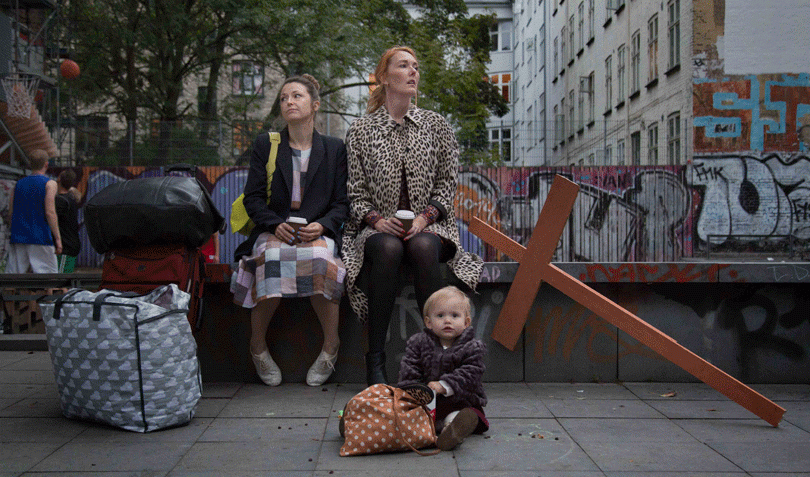
However, the success of recent Danish television comedy has found its inspiration in the American comedy tradition and its relationship to celebrity culture and the relatively new influence of reality TV. No recent Danish comedy series has enjoyed the widespread attention of Clown, which is inspired by Larry David’s Curb Your Enthusiasm (2000-2011) and whose depiction of two famous comedians and their private and professional musings among Danish A-list celebrities has encouraged a new theoretical term, fiktio-biografisme or ‘fictio-biography’, coined by communications scholar Louise Brix Jacobsen (2012). The term is a means to study and discuss the triangular relation between the series, the media representations of its stars and the spectators, thus making it relevant for the comparison of Ditte Hansen’s and Louise Mieritz’s representations of their own public personas in Ditte & Louise.
On the surface, Ditte & Louise appears to have a certain familiarity with Clown, which the protagonists even reference in the first episode, denying the possibility for two women to copy the concept. “Vaginas aren’t funny,” says Ditte in the first episode, and Louise agrees. Both series feature two Danish comedians playing a partly fictionalized version of themselves, and yet there are substantial differences. Clown’s two male protagonists never experience the pain and regret repeatedly felt by Ditte and Louise, as their strategies for life and art fail.
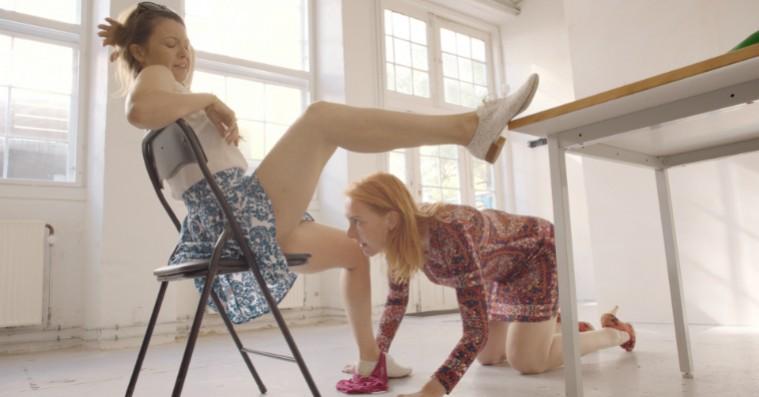
They do, nevertheless, share a focus on showing and discussing issues connected to sex and success with a seemingly filter-less approach, tackling both bodily shame and sexual embarrassment as well. “Clown paved the way for us by making the Danes used to what you can call ‘the embarrassing space’. When the series first aired, I was unable to remain seated in the living room,” recalls Mieritz (Hansen and Mieritz 2015), referring to Christensen and Hvam’s depiction of their characters’ frequent sexual and bodily escapades. Both series make use of well-known comedians, who double as head writers, but with differing impact. According to Brix Jacobsen (2012), Clown’s representation of real-life persons serves a purpose of negotiating identity structures in a modern media world, where fame equals status. Because Hvam and Christensen were already national icons as famous comedians when creating the series, their personas in the series play against the images frequently procured and cultivated by tabloid media. In this way, the result connects the fictional work with the media and the audience (Jacobsen 2005: 4-5), ironically reflecting current celebrity culture.
Write what you know – Ditte & Louise as comedy verité
With its hand-held camera and documentary style Clown’s stylistically represents Brett Mills’ game-changing notion of the comedy verité, initially expressed in an article in a 2004 article in Screen. Brett Mills identifies a new trend in the sitcom based upon his analysis of Ricky Gervais’ The Office (2001-2003), which, he argues, draws on the cinema verité tradition. It marks the point at which “[p]rogrammakers have begun to abandon some of the [traditional sitcom] genre’s most obvious conventions and replaced them with the formal characteristics of other distinct genres” (Mills 2004: 68). Mills argues that comedy verité like The Office’s mockumentary style makes use of features from documentary genres. This style is promoted by an ambition to convey a sense of truth or authenticity. Comedy verité thus salutes its source of inspiration, cinema verité, by making use of a ‘faux-improvisational style’ by applying handheld cameras and abandoning ‘the fourth wall’. By doing this, the “programme uses the visual signifiers of another new form of television: the docusoap” (Ibid: 69). Comedy verité’s two most poignant tropes are the documentary style as an aesthetic approach and the representational approach of performers playing a sometimes partly fictionalized version of themselves.
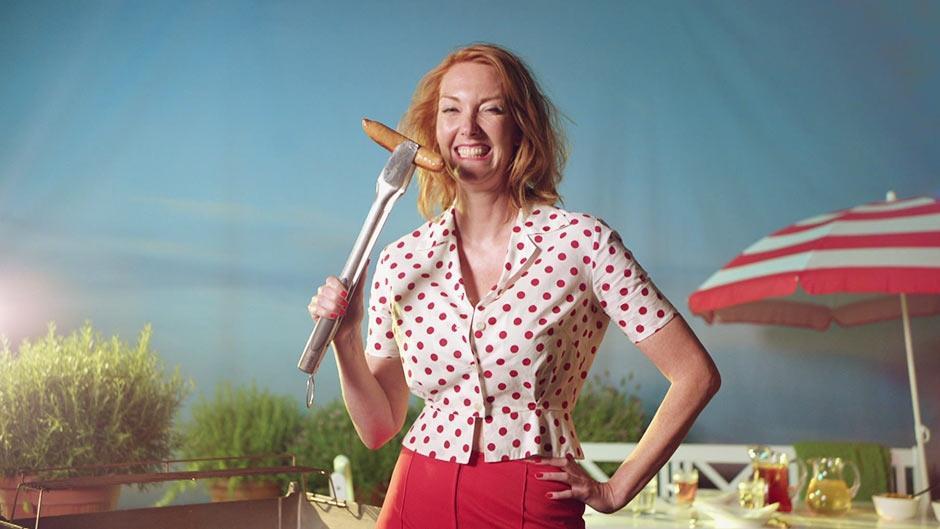
To add to Mills’ (2004) notion of comedy verité, Trisha Dunleavy, in her article ‘Hybridity in TV Sitcom: The Case of Comedy Verité’, argues that comedy verité marks a parting of the TV comedy genre from the conventional sitcom “in that it marries the sitcom’s situational stasis with the real-life situations constructed in docusoaps” (Dunleavy 2008: 1). Through situations that emulate events in docusoaps, it springs from a premise anchored in humour, while at the same time benefiting from conventional sitcom’s possibilities for serial longevity.
Dunleavy considers the hybrid nature of comedy verité and identifies an increasing number and cultural spread of sitcoms that reference the concepts and aesthetics of ‘reality’ TV, which are the set of conventions that now constitute it. Exploiting the new outlets for humour facilitated by its hybridity, comedy verité has upgraded the live action sitcom for a popular culture now steeped in the “aesthetics, concerns and even the jargon of ‘reality’ TV” (Dunleavy 2008: 3). Among the six conventions which Dunleavy identifies as constituting the comedy verité genre, she finds a focus on flawed, incorrigible characters and a touch of reality, as well as a self-consciousness in the comic performance. She concludes: “Working alongside multi-camera, animated and single-camera form as a fourth variant of contemporary sitcom, comedy verité has also contributed to the necessary revitalisation of one of television’s oldest, most cherished genres” (Dunleavy 2008: 3).
Approaching Ditte & Louise with reference to Mills’ and Dunleavy’s definitions, the series bears several resemblances to comedy verité. Hansen and Mieritz explain how they are not interested in pointing to a meta-oriented sense of style meta-wise, but rather, creatively supported by the series’ photographer, director and production designer, aim to convey a visual strategy with the ambition to place the spectator within the story universe and create a bond between the protagonists and the spectator. This is opposed to the distance, which Clown creates by establishing a gap between the audience and the celebrities they look upon on the screen. Ditte & Louise does, however, work within the definitions of comedy verité to the extent that the series attempts to depict a true image of the business in which they work by establishing “an intense docu-feel with dialogue, that feels improvised” (Hansen and Mieritz 2015). Moreover, their pitch mentions reality TV as a source of inspiration for a raw, realist feel (Hansen and Mieritz 2012). Hansen and Mieritz do not improvise their acting, but make use of improvisational processes during the writing as a means to create said documentary feeling. They, in fact, state that even if their series “stand on the shoulders of Clown, they are not inspired by it” (Hansen and Mieritz 2015).
Instead, they have found their main inspiration in American series such as Louie (2010-) and Girls (2012-), whose characters share Ditte and Louise’s attempted naked vulnerability, and in Ricky Gervais’ Extras (2005–2007), which draws its reality feel from featuring real life movie stars playing ironic versions of themselves in every episode. This inspiration sparked a wish to present true characters and encouraged a decision to use their own personalities in the stories, but, for comedic effect, to make the protagonists less successful than Mieritz and Hansen (who, unlike their fictional alter egos, do not lack work as actors and comedians in theatre, movies and television).
We decided to use our own weaknesses and points of pain, letting our characters reflect our own personalities to a pretty high degree. We did lower Ditte and Louise’s professional status, compared to our own, because there is no humour in success. We have given them a completely different personal situation than our own, but most of the stuff that happens to them professionally stem from experiences we have had ourselves”.
(Hansen and Mieritz 2015).
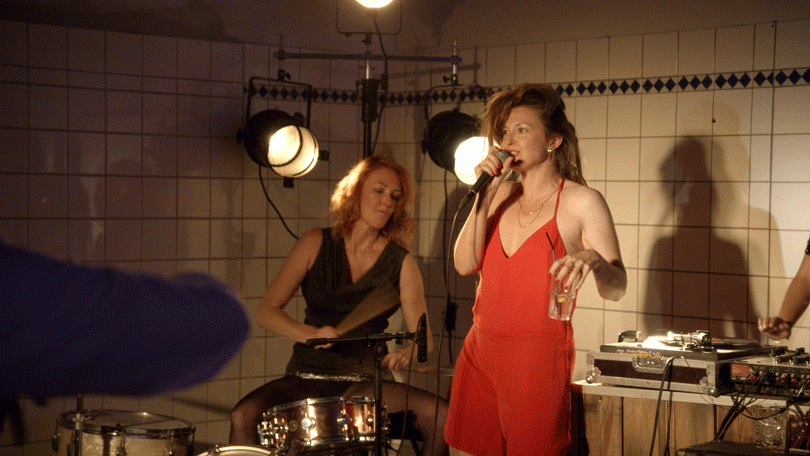
By using their own names and by featuring real celebrities in cameos, they explain that they “appeal to the audience’s curiosity” but stress that the intention of Ditte & Louise is not to discuss the topic of celebrity (Ibid.). Rather, it aims to be a gender-oriented uproar in an industry in which women are at the receiving end of discrimination based upon age and looks.
Being Ditte and Louise – the performance of the self
In his later analysis of the British series The Bob Brydon Show (2010-2012) in the article Being Rob Brydon (2010), Brett Mills finds it difficult to distinguish whether or not Brydon the actor is exposing himself according to the ideals of the actors’ ability to perform, because we do not know to what extent he draws on personal experience. In the series, the actor plays a version of himself. But, due to the traditions of stand-up comedy, the comedic genres allow the actors to play themselves, without necessarily delivering personal material, the way the comedian does in front of the microphone. Hence, “because comedians can play themselves we never know or not if they are” (Mills 2010: 13).
Influenced by Richard Dyer’s idea of the star (1988, cited in Mills 2010), the key for Mills is that ‘stars play characters, that is, constructed representations of persons. Thus, a star performance typically may gain some of its meaning through the relationship between the reality of the star and the character he or she portrays, but at no point is there an assumption of equivalence between the two. Umberto Eco also reflects this approach, when he defines the actor in the process of acting as someone, who indirectly announces that he is “about to lie” (Mills 2010: 6).
Mills argues that the “‘celebrity-commodity’ is often required to give up some portion of their private selves for public consumption, and their meaning and pleasures often rests on an assumption that we are given access to at least some aspect of their real selves. Of course, it is accepted that celebrities never fully reveal themselves, and the version of themselves that they offer is likely to be managed quite tightly in order to make sense. In the case of The Rob Brydon Show, where the title’s British comedian plays a fictionalized version of himself, we are left to judge for ourselves, but Mills generalizes:
[I]t makes little sense to try and work out to what extent a celebrity is giving us access to themselves; after all, since Erving Goffman’s analysis of ‘performance’ (1971/1959) it has been accepted that all social activity is a negotiated act which takes into account a whole range of contextual factors and societal norms. By this account it is meaningless to ask whether anyone is ever ‘true’ to themselves; the question instead becomes why is this performance chosen by this person at this time?”.
(Mills 2010: 10).
With reference to Hansen and Mieritz’s phrased intentions, Ditte & Louise arguably defies Mills’ denial that we can ask whether they as performers are ‘true’ to themselves. Their stated ambition to address gender issues – as well as making the audience laugh – in the acting and comedy business can thus be said to benefit from their revelations by drawing on their own personalities (Hansen and Mieritz 2015a). This became a challenge for both of them when they moved from the part of head writers to the part of actors, because they “suddenly realized” how naked they felt, having to play versions of themselves so close to reality (Ibid.). However, the documentary element or ‘feel’, enhanced by the ‘honesty’ and ‘lack of vanity’ put forward by Ditte & Louise, is stressed in a variety of positive reviews of the series (Hertzum 2015, Rud 2015, Viftrup 2015). Hansen and Mieritz’s performances are equally praised; both were nominated for the best actress Robert Awards – for playing themselves.
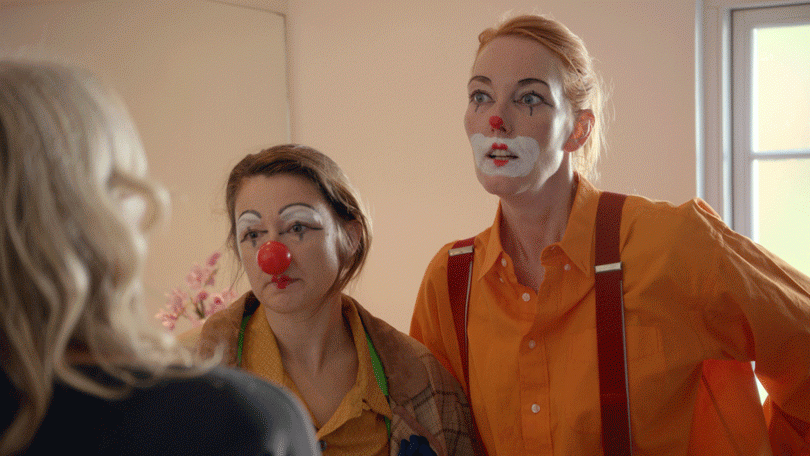
Mills’ urges us through Goffmann to accept that there is no ‘true self’ in fictional artefacts, but varying forms of the performance of the self. In the case of Ditte & Louise, it can thus be argued that the creators intentionally play with and present a high degree of ‘truthfulness’ in the spectator’s perceptions of their ‘true’ selves, in order to create a bond. At the same time, they also eliminate certain similarities (other than their real-life family situations which are not reflected in the series) to their own lives for comic purposes, for example, the social status of Ditte and Louise. They do, in any case, admit to having a number of psychological characteristics in common with their characters, and find this to be a strategic choice to serve the narrative. Nevertheless, as stated by Mieritz: “We play ‘Ditte’ and ‘Louise’, not Ditte Hansen and Louise Mieritz” (Hansen and Mieritz 2015).
Unruly women – Danish TV’s rebellious comedy heroines
Ditte and Louise as characters, who perform comedy, echo Danish female comedian couples from the 1980s and 1990s such as Ryslinge and Helger and Søs and Kirsten, yet in the context of contemporary comedy, Mieritz and Hansen’s choice of genre and form show a closer resemblance to characters from an American sitcom tradition. On an interesting note, Ditte & Louise merges elements of comedy verité with an iconic American female comedy trope, the unruly woman.
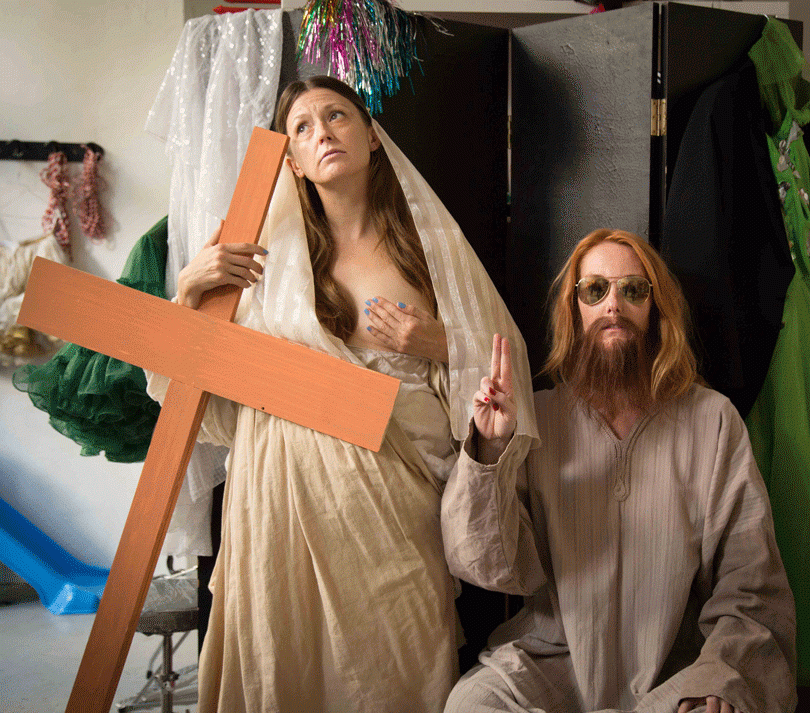
Through analyses of the sitcoms I Love Lucy (1951-1957) and Roseanne (1988-1997), Kathleen Rowe identifies a type of female character who rebels against male domination by challenging conventional female stereotypes. Playing a housewife who continually – but always in vain – tries to break away from her somewhat caged role in life in I Love Lucy, Lucille Ball paved the way for more rebellious female characters on prime time TV. She does this because she, like the quintessential unruly woman, “breaks the rules, makes fun of them and makes a spectacle of herself as an embodiment of success” (Rowe 1995: 31). And, this enables her to do what men have always done, argues Kathleen Rowe, which is to position themselves visually – and thereby conquer the power over how she is seen.
The unruly woman’s weapon is her laughter and she draws on the tradition of the ‘carnivalesque’ or grotesque woman to develop her own criteria of unruliness. She is based in Mikhail Bakhtin’s discussion of the ‘carnivalesque’ (Rowe 1995), which provides a starting place to question power dynamics of social interactions and hierarchies with the intention to make fun of cultural norms and conventional power structures.
This becomes noteworthy in the context of examples of the criticism, which Ditte & Louise has met, presented by for instance a newspaper critic, who described Ditte & Louise as a series about “ghastly phenomenons [sic] such as cellulitis, self-hatred, sexuality and motherhood” (Palle 2014). All the while, a cultural commentator criticized Hansen and Mieritz’ tendency to expose themselves, their flaws and their aging bodies in the comedy series making women feel ashamed of their gender (Gotfredsen 2015).
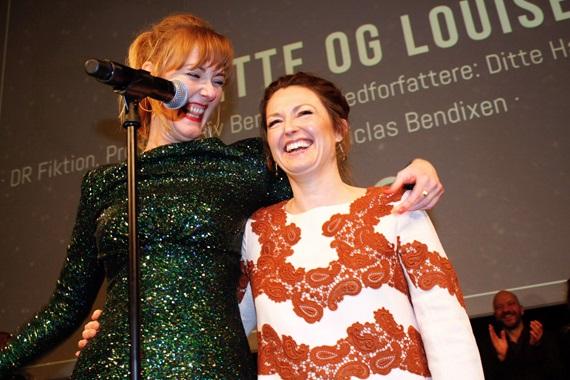
Although, Ditte Hansen and Louise Mieritz, publicly apologized to their critics, when they accepted the Robert Award, it did not seem to suggest an intention of authenticity or truthfulness in this occasion.
Ditte & Louise updates the unruly woman with the potentials and pitfalls ascribed to her particular breed of popular culture.
Conclusion
Although Ditte & Louise celebrates the comedian’s dictum to ‘make ’em laugh’, the series aims to mirror the representation of the female comedian in popular culture as well as the naturalistic representation of women in general. Not through depicting women in comedy or women over 40 as successful celebrities, but indirectly through a comical piece of fictional work. By merging the traditional sitcom with comedy verité’s strategies for authenticity and selected elements of style from the art film, Ditte & Louise serves up an attempt to imitate life as we know it, without filters or photo-shopping, with its two actors often posing naked or half-naked without makeup.
However, presenting themselves as anti-heroines and the opposite of super women or role models is Ditte Hansen and Louise Mieritz’ storytelling strategy. Showcasing ‘the real us’ becomes their variation on the form of the performance of the self, just as the style choices of the TV series’ imitate art film, art photography and drama, thereby attempting to lend integrity to a genre, the situational comedy, which is associated with commercial family entertainment and rarely takes home the cool points of the art house genres.
The performance of the self in the practice of Ditte & Louise then functions as a strategy to create an allegiance with the audience. This allegiance is based upon the spectator’s expectations for the series to be, if not ‘true’, then at least a representation of current truths about the representation of gender in the world of entertainment, and perhaps beyond. Through this manoeuvre, the strategy in the series’ storytelling, as well as in the acting and style choices, works to invoke admiration – if not for the characters, who are anti-heroines, then for the ‘truthfulness’ and ‘integrity’ the series subscribes to in its representation of contemporary women in comedy.
AF: IBEN ALBINUS SABROE / FILMANMELDER, FORFATTER OG UNDERVISER/ SYDDANSK UNIVERSITET
ben Albinus Sabroe is a film critic, author and screenwriting teacher at SDU (University of Southern Denmark).
References
Bech, Charlotte (2016). Research interview by Iben A. Sabroe. February 12th.
Claro, Manuel Alberto (2015). Mood book Ditte & Louise. Courtesy of Danish Broadcasting Corporation, Copenhagen.
Didriksen, Karina (2016). “Ditte og Louises sjove takketale til Robert-festen”. In: B.T. February 8th. http://www.billedbladet.dk/kendte/danmark/tv/dr/video-ditte-og-louises-sjove-takketale-til-robert-prisen.
Dunleavy, Trisha (2008). “Hybridity in TV Sitcom: The Case of Comedy Verité”. Victoria: University of Wellington.
Gotfredsen, Sørine (2015). “I mødet med Ditte & Louise føler jeg mig flov på kvinders vegne”. In: Berlingske Tidende, June 12th, 2015. http://www.b.dk/kommentarer/i-moedet-med-ditte-louise-foeler-jeg-mig-flov-paa-kvinders-vegne
Hansen, Ditte and Mieritz, Louise (2012). Pitch Ditte & Louise, courtesy of Danish Broadcasting Corporation Copenhagen.
Hansen, Ditte and Mieritz, Louise (2015). Research interview by Iben A. Sabroe. November 20th.
Hertzum, Naja Helene (2015). “Ditte og Louise”. In: Soundvenue.dk, http://soundvenue.com/film/2015/06/ditte-og-louise-149424 [2 June 2015].
Jacobsen, Louise Brix (2011). ”Fiktiobiografisme. Perception og fiktionalisering”. In: Spring. Nr. 31-32. S. 57- 78.
Jacobsen, Louise Brix (2012). Fiktiobiografisme. Fiktionalisering som performativ strategi i dansk film og tv fra 2005 og frem. Ph.d.-afhandling. Institut for Æstetik og Kommunikation, Aarhus Universitet.
Kaplan, Steve (2013). The Hidden Tools of Comedy – The Serious Business of Being Funny. Studio City, Michael Wiese Productions.
Mills, Brett (2004). “Comedy Verité. Contemporary Sitcom Form.” In: Screen Vol. 45. No. 1, pp. 53-78. http://screen.oxfordjournals.org/content/45/1/63.extract.
Mills, Brett (2010). Being Rob Brydon: performing the self in comedy. School of Film and Television Studies. University of East Anglia.
Mintz, Lawrence E. (1988). “Situation Comedy”. In: Brian Rose, (ed.) TV-genres. A Handbook and Reference Guide. Westport, Greenwood Press, pp. 107-123.
Neale, Steve & Krutnik, Frank (1990). Popular Film and Television Comedy. New York, Routledge.
Palle, Henrik: “Ny dansk tv-serie giver kvinderne det glatte lag. In: Politiken, June 4th, 2014, http://politiken.dk/kultur/filmogtv/tvanmeldelser/premium/ECE2700960/ny-dansk-tv-serie-giver-kvinderne-det-glatte-lag/
Redvall, Eva N. (2013). Writing and Producing Television Drama in Denmark: From The Kingdom to The Killing. Basingstoke: Palgrave Macmillan.
Rowe, Kathleen (1995). The Unruly Woman: Gender and the Genres of Laughter. Austin, Texas: University of Texas.
Rowe, Kathleen: ”Comedy, Melodrama and Gender: Theorizing the Genres of Laughter”. In: Karnick, K. B. & Jenkins, H. (ed.): Classical Hollywood Comedy, New York & London: Routledge, 1995, p. 39-59.
Rud, Ida: ”Ditte og Louise”, In: Ekko, 4. Juni. 2015, http://www.ekkofilm.dk/anmeldelser/ditte-louise/
Viftrup, Michael: ”Tårnhøj karakter til DR-serie - en ny ’Klovn’? TV2.dk, June 12th, 2015: http://tvtid.tv2.dk/2015-06-12-taarnhoej-karakter-til-dr-serie-en-ny-klovn
List of TV series
Arvingerne/The Legacy. 2014-. Cr: Maja Ilsøe; Denmark, DR
Curb Your Enthusiasm. 2000–2011. Cr: Larry David; USA, HBO, 30 mins eps.
Ditte & Louise. 2015–. Cr: Ditte Hansen and Louise Mieritz.
Klovn/Clown. 2005-2009. Cr: Casper Christensen and Frank Hvam; Denmark, TV2 Zulu, 25 mins x 60 eps.
Extras. 2005–2007. Cr: Ricky Gervais. England, BBC.
Girls. 2012–. Cr: Lena Dunham. USA, HBO.
I Love Lucy (1950-1957).
Inside Amy Schumer. (2013-). Cr: Amy Schumer and Daniel Powell. USA, Comedy Central.
Kongeriget. 1998-2002. Cr: Søs Egelind and Kirsten Lehfeldt; Denmark, TV2. 4 x 12 episodes x 22 mins.
Langt fra Las Vegas/Far From Las Vegas. 2001-2003. Cr: Casper Christensen and Frank Hvam; Denmark, TV2 Zulu, 30 mins x 53 eps.
Louie. 2010–. Cr: Louie C. K. USA, FX.
Lykke/Happy Life. 2011-2012. Cr: Hanna Lundblad and Stig Thorsboe; Denmark, DR, 58 mins x 18 eps.
Nynne. 2006. Cr: Iben Gylling, Camilla Hübbe; Denmark, TV3, 45 mins x 13 eps.
Rita. 2012–. Cr: Christian Torpe. Denmark, TV2.
Roseanne (1988-97). Cr. Matt Williams. USA, ABC, 23 mins x 222 eps.
The Office. 2001-2003. Cr. Ricky Gervais. England, BBC.
Togetherness. 2015–. Cr. Mark and Jay Duplass. USA, HBO.
Kildeangivelse
Sabroe, Iben Albinus (2016): True Comediennes: A Case Study of Comedy Verité and Performance of the Self in the Danish TV Series Ditte & Louise. Kosmorama #263 (www.kosmorama.org).
